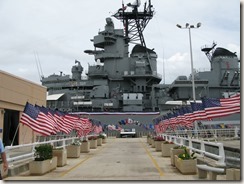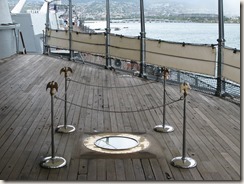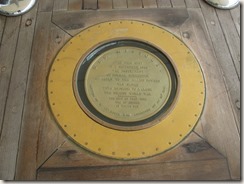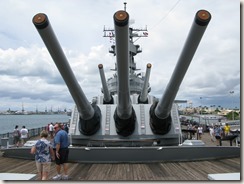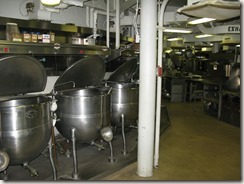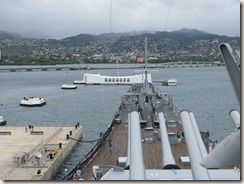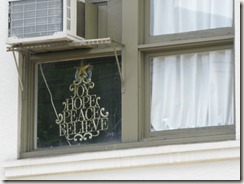Oahu Day 2: Mighty Mo and reflections on WWII
Our last stop on our Pearl Harbor tour was the U.S.S. Missouri. You have to take a bus to get to the Missouri, as it's moored on Ford Island, an active military base.
As you drive out to the island, there's an announcement on the bus intercom about not taking pictures during the drive. Once you're there, you walk across the dock to the battleship directly ahead of you.
It was on the U.S.S. Missouri that the Japanese Empire surrendered to the Allied Forces on September 2, 1945. A plaque now commemorates the spot where the surrender document was signed.
Besides being the location of this historic event, I learned a lot about the Missouri:
- She was the last battleship built by the United States. With modern aircraft and aircraft carriers, battleships became obsolete.
- She was decommissioned in 1955 after fighting in World War II and the Korean War.
- She was reactivated and modernized in 1984 as part of the Navy's 600-ship Plan and went on to fight in Operation Desert Storm in 1991. (I guess battleships weren't obsolete.)
- The U.S.S. Missouri Memorial Museum organization must keep the ship ready to go back to sea. (Now the ending of the movie Battleship makes a little more sense.)
- She barely fits through the Panama Canal and makes horrible sounds as she scrapes through it.
- The teak deck is in poor shape and is currently being refinished. Here's the difference between the refinished deck (on the left) and the weathered deck (on the right):
- She has nine 16-inch guns that can fire a 2,700-pound shell 23 miles.
But what most surprised me about the ship was its size. When we traveled through the decks below, it felt like a small city, complete with offices, kitchens, computer rooms, bunk rooms, and everything else. Of course the officers' areas have more space.
Here's a view from the bridge with the Arizona Memorial in the distance.
Reflections on World War II
Seeing these two memorials together like this kept bringing me back to the same questions about World War II: Why did it happen? Could it have been avoided?
As I walked around these memorials with many Japanese tourists, I wondered why these people who are now our friends had become the enemy by 1941. After all, the Japanese were our allies in World War I.
To understand why the Japanese attacked, you have to go back to 1870, when it became a modernized nation. With this change came a powerful, modern military. But Japan was also dependent on other nations, as it lacked natural resources. If you don't have the resources you need, you either trade for them or take them from other nations.
Japan began to flex its military muscles at the end of the 19th century and beginning of the 20th century. They went to war with China from 1894-1895 and Russia from 1904-1905. The result was that Japan became the dominant power in the Far East. They also achieved their objective of creating a larger buffer against future attacks.
The Great Depression pushed Japan over the edge into total militarization and Fascism, similar to what was happening in Germany. In 1931, Japan invaded Manchuria. After international outrage, Japan resigned from the League of Nations.
By 1937, Japan was in a full-scale war with China. As atrocities mounted from Japan's occupation, including the Nanking Massacre, the U.S. supported China with money, fighter pilots (The Flying Tigers), and supplies. When Japan invaded French Indochina in 1941, the U.S. froze all Japanese assets and cut off its oil supply (the U.S. supplied 80% of Japan's oil).
With its back against the wall, Japan became even more aggressive. Plans were made to knock out the U.S. fleet stationed on Oahu. With that fleet destroyed, Japan could continue its conquest across the Pacific, unchallenged.
But beyond an initial victory at Pearl Harbor, it didn't turn out well for Japan. At the end of the war:
- 2,620,000 to 3,120,000 million Japanese had been killed (military and civilians)
- Millions of people were slaughtered by the Japanese during their conquests and occupations (the number is somewhere between 5.4 - 30 million, but we'll never really know)
The conclusion I've come to is that wars will happen. Countries (or certain people in them) will want things they don't have (including strategic locations or resources). The invention of the atomic bomb changed the nature of war, as was seen throughout the Cold War. And then terrorism in the 21st century changed it again. Through it all, the military industrial complex has continued to feed the machine.
So all I can hope for is that our leaders learn from their mistakes and we never have a war like World War II again.
Here's a sign I saw in Chinatown in Honolulu that sums everything up pretty well:
